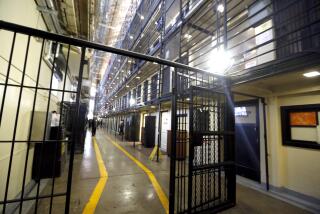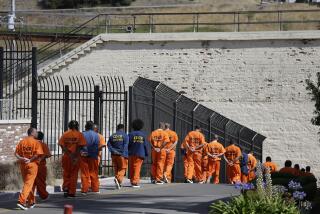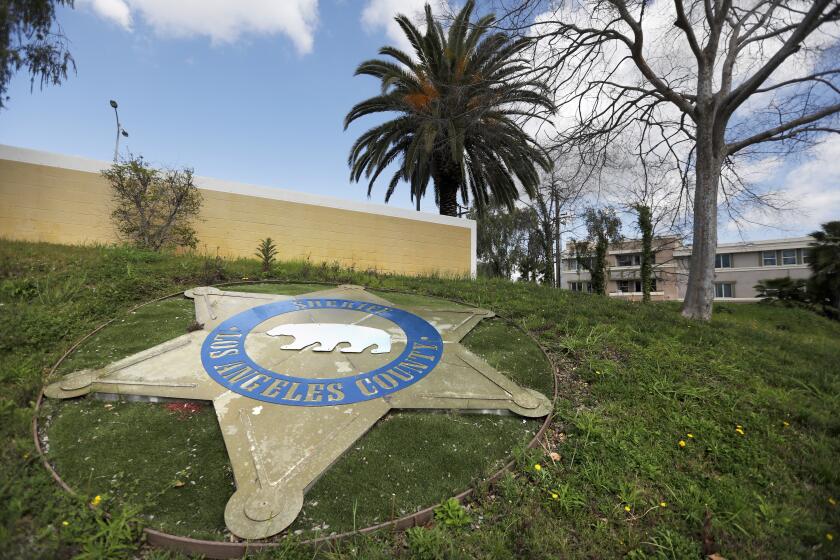Gov. Jerry Brown wins two more years to reduce prison crowding
SACRAMENTO — Gov. Jerry Brown on Monday won two more years to reduce prison crowding, a significant victory in his protracted battle with federal judges over inmate numbers.
The judges gave the governor until the end of February 2016 to ease crowding to levels they consider safe and imposed a schedule for doing so. In return, the administration must immediately make more inmates — mostly the elderly and ill — eligible for parole.
Monday’s ruling averts a potentially explosive showdown between Brown and the judges before the governor officially launches his expected reelection campaign. It also reduces the chances that Brown will be forced to release inmates early — although if the state misses any of the court’s new deadlines, a yet-to-be-named official will have the power to set prisoners free.
“It is obviously very good news for the governor,” said Raphael Sonenshein, executive director of the Pat Brown Institute for Public Affairs at Cal State L.A. The prospect of public backlash over mass prison releases, even those ordered by a court, “did have potential for creating problems for what is largely a smooth reelection campaign.”
The judges’ first benchmark is June 30, by which time the state must shed 1,000 inmates from its lockups, despite an increase in the rate at which they are arriving.
California now has 117,600 prisoners in prisons built for 81,600, and just over 12,200 more are housed in contract beds scattered across four states. The administration’s most recent projections show that without changes, California will add about 10,000 inmates in the next four years.
In agreeing to Brown’s request for a delay, the panel of three judges — who last spring excoriated the governor for defying their orders — cite his proposal to end the legal tussle and to “consider the establishment of a commission to recommend reforms of state penal and sentencing laws.”
The governor has not announced a concrete plan for the formation of such a panel.
Lawyers for inmates say a constitutional crisis has been avoided now that the judges won’t have to carry out their threat to hold Brown in contempt. But otherwise the attorneys found little to like.
“We’re quite disappointed,” said Michael Bien, lead lawyer for about 33,000 inmates in a class-action case over prison mental health care. “There is no justification for the delay. All of the things they are talking about doing now, they could have done years ago.”
Republican critics of Brown’s prison policies were upset that the state must now put more felons on parole, even through credits for good behavior.
“This court order is tragic,” said a statement from state Sen. Jim Nielsen (R-Gerber), a frequent critic of Brown’s criminal justice record. “Once released, these dangerous felons will threaten our local communities, where residents are already suffering from increased crime and where police agencies are overburdened.”
But state Senate leader Darrell Steinberg (D-Sacramento), who had worked independently to negotiate a settlement between the state and the court, called the outcome “the best of both worlds.”
The state now has the time to invest in rehabilitation programs aimed at keeping offenders from returning to prison once they are released, he said, while the inmate population “continues to be reduced in real and enforceable ways.”
Steinberg, an advocate for the revision of California’s sentencing laws, nodded to political realities by adding, “There’s no question sentencing reform has to be the twin of these investments.... It is probably better in a non-election year.”
Brown also has acknowledged the political realities of the prolonged crisis. He has been meeting with law enforcement agencies and prosecutors across the state to talk about the effects of his first pass at reducing prison crowding — a law that since late 2011 has diverted lower-level felons and parole violators to county jails, many of them already overcrowded.
Under the judges’ Monday order, Brown must immediately go forward with plans he announced last month. Those include expanding eligibility for parole for inmates who are medically incapacitated or those over 60 who have spent at least 25 years in prison.
He must also allow “second-strikers” whose crimes were nonviolent to shave off up to a third of their prison time through good behavior or participation in rehabilitation programs. And those prisoners must be considered for parole when they have served half their sentence.
Brown’s administration also agreed to open programs at 13 prisons to help prepare inmates for release and to pursue discussions on opening similar facilities in some counties.
The two-year grace period from U.S. District Judges Lawrence Karlton and Thelton Henderson and 9th Circuit Court of Appeals Judge Stephen Reinhardt frees up money Brown said he would have otherwise used to lease more custody beds. In his budget proposal last month, the governor earmarked $40 million for the reentry programs now required by the court.
The judges’ order also comes with a continued freeze on the number of beds California can rent in other states.
More to Read
Start your day right
Sign up for Essential California for news, features and recommendations from the L.A. Times and beyond in your inbox six days a week.
You may occasionally receive promotional content from the Los Angeles Times.







